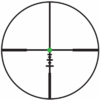js8588
Member
I freely admit, I'm new to the optics game. As per my recent post, I only just bought my first scope.
A big part of that is because of analysis paralysis brought on by the myriad of choices in brands, magnification ranges and reticles.
I've read a LOT of forum posts, articles, and watched literally hours worth of YouTube videos on the topic.
I noticed an interesting trend.
When discussing personal defense rifles and scopes, Christmas tree, BDC, ACSS, etc reticles were always recommended.
When talking about hunting say, dangerous game or hogs (still technically dangerous game), a simple, uncluttered German #4 with an illuminated dot or similar (Leupold Firedot duplex, Trijicon illuminated triangle post) is usually considered the go-to.
Sense where I'm going with this?
I get that Ballistic ranging reticles are useful when shooting for a perfect score to impress your buddies or win a game, but if needed for personal defense, wouldn't the same concepts apply as those when hunting something that could injure/kill you?
Red dot sights are considered useful to 200 yards+ (probably because 55-69gr 5.56 ammo basically has a 300ish yard mpbr).
LPVOs are popular because they work like red-dots with some additional magnification.
When adrenaline is high & your life may be on the line, isn't simple better? Are you really going to remember which hash mark means what at certain (likely at the time, if you're in a situation where it's needed, unknown) distances?
Am I missing something?
A big part of that is because of analysis paralysis brought on by the myriad of choices in brands, magnification ranges and reticles.
I've read a LOT of forum posts, articles, and watched literally hours worth of YouTube videos on the topic.
I noticed an interesting trend.
When discussing personal defense rifles and scopes, Christmas tree, BDC, ACSS, etc reticles were always recommended.
When talking about hunting say, dangerous game or hogs (still technically dangerous game), a simple, uncluttered German #4 with an illuminated dot or similar (Leupold Firedot duplex, Trijicon illuminated triangle post) is usually considered the go-to.
Sense where I'm going with this?
I get that Ballistic ranging reticles are useful when shooting for a perfect score to impress your buddies or win a game, but if needed for personal defense, wouldn't the same concepts apply as those when hunting something that could injure/kill you?
Red dot sights are considered useful to 200 yards+ (probably because 55-69gr 5.56 ammo basically has a 300ish yard mpbr).
LPVOs are popular because they work like red-dots with some additional magnification.
When adrenaline is high & your life may be on the line, isn't simple better? Are you really going to remember which hash mark means what at certain (likely at the time, if you're in a situation where it's needed, unknown) distances?
Am I missing something?


